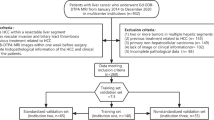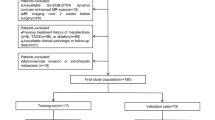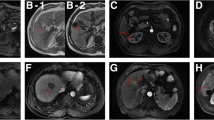Abstract
Background
Prediction models with or without radiomic analysis for microvascular invasion (MVI) in hepatocellular carcinoma (HCC) have been reported, but the potential for model-predicted MVI in surgical planning is unclear. Therefore, we aimed to explore the effect of predicted MVI on early recurrence after anatomic resection (AR) and non-anatomic resection (NAR) to assist surgical strategies.
Methods
Patients with a single HCC of 2–5 cm receiving curative resection were enrolled from 2 centers. Their data were used to develop (n = 230) and test (n = 219) two prediction models for MVI using clinical factors and preoperative computed tomography images. The two prediction models, clinico-radiologic model and clinico-radiologic-radiomic (CRR) model (clinico-radiologic variables + radiomic signature), were compared using the Delong test. Early recurrence based on model-predicted high-risk MVI was evaluated between AR (n = 118) and NAR (n = 85) via propensity score matching using patient data from another 2 centers for external validation.
Results
The CRR model showed higher area under the curve values (0.835–0.864 across development, test, and external validation) but no statistically significant improvement over the clinico-radiologic model (0.796–0.828). After propensity score matching, difference in 2-year recurrence between AR and NAR was found in the CRR model predicted high-risk MVI group (P = 0.005) but not in the clinico-radiologic model predicted high-risk MVI group (P = 0.31).
Conclusions
The prediction model incorporating radiomics provided an accurate preoperative estimation of MVI, showing the potential for choosing the more appropriate surgical procedure between AR and NAR.




Similar content being viewed by others
References
Sung H, Ferlay J, Siegel RL, et al. Global Cancer Statistics 2020: GLOBOCAN estimates of incidence and mortality worldwide for 36 cancers in 185 Countries. CA Cancer J Clin. 2021;71(3):209–49.
Forner A, Reig M, Bruix J. Hepatocellular carcinoma. Lancet. 2018;391(10127):1301–14.
Marrero JA, Kulik LM, Sirlin CB, et al. Diagnosis, staging, and management of hepatocellular carcinoma: 2018 practice guidance by the american association for the study of liver diseases. Hepatology. 2018;68(2):723–50.
European Association for the Study of the Liver. EASL Clinical Practice Guidelines: Management of hepatocellular carcinoma. J Hepatol. 2018;69(1):182–236.
Wu JC, Huang YH, Chau GY, et al. Risk factors for early and late recurrence in hepatitis B-related hepatocellular carcinoma. J Hepatol. 2009;51(5):890–7.
Chan AWH, Zhong J, Berhane S, et al. Development of pre- and post-operative models to predict early recurrence of hepatocellular carcinoma after surgical resection. J Hepatol. 2018;69(6):1284–93.
Lim KC, Chow PK, Allen JC, et al. Microvascular invasion is a better predictor of tumor recurrence and overall survival following surgical resection for hepatocellular carcinoma compared to the Milan criteria. Ann Surg. 2011;254(1):108–13.
Rodriguez-Peralvarez M, Luong TV, Andreana L, Meyer T, Dhillon AP, Burroughs AK. A systematic review of microvascular invasion in hepatocellular carcinoma: diagnostic and prognostic variability. Ann Surg Oncol. 2013;20(1):325–39.
Chen ZH, Zhang XP, Feng JK, et al. Actual long-term survival in hepatocellular carcinoma patients with microvascular invasion: a multicenter study from China. Hepatol Int. 2021;15(3):642–50.
Shindoh J, Andreou A, Aloia TA, et al. Microvascular invasion does not predict long-term survival in hepatocellular carcinoma up to 2 cm: reappraisal of the staging system for solitary tumors. Ann Surg Oncol. 2013;20(4):1223–9.
Hwang S, Lee YJ, Kim KH, et al. The impact of tumor size on long-term survival outcomes after resection of solitary hepatocellular carcinoma: single-institution experience with 2558 patients. J Gastrointest Surg. 2015;19(7):1281–90.
Sheng X, Ji Y, Ren GP, et al. A standardized pathological proposal for evaluating microvascular invasion of hepatocellular carcinoma: a multicenter study by LCPGC. Hepatol Int. 2020;14(6):1034–47.
McHugh PP, Gilbert J, Vera S, Koch A, Ranjan D, Gedaly R. Alpha-fetoprotein and tumour size are associated with microvascular invasion in explanted livers of patients undergoing transplantation with hepatocellular carcinoma. HPB (Oxford). 2010;12(1):56–61.
Cucchetti A, Piscaglia F, Grigioni AD, et al. Preoperative prediction of hepatocellular carcinoma tumour grade and micro-vascular invasion by means of artificial neural network: a pilot study. J Hepatol. 2010;52(6):880–8.
Lei Z, Li J, Wu D, et al. Nomogram for preoperative estimation of microvascular invasion risk in Hepatitis B Virus-Related Hepatocellular Carcinoma within the Milan Criteria. JAMA Surg. 2016;151(4):356–63.
Chou CT, Chen RC, Lin WC, Ko CJ, Chen CB, Chen YL. Prediction of microvascular invasion of hepatocellular carcinoma: preoperative CT and histopathologic correlation. AJR Am J Roentgenol. 2014;203(3):W253-259.
Renzulli M, Brocchi S, Cucchetti A, et al. Can Current preoperative imaging be used to detect microvascular invasion of hepatocellular carcinoma? Radiology. 2016;279(2):432–42.
Gillies RJ, Kinahan PE, Hricak H. Radiomics: Images Are More than Pictures, They Are Data. Radiology. 2016;278(2):563–77.
Zheng J, Chakraborty J, Chapman WC, et al. Preoperative Prediction of Microvascular Invasion in Hepatocellular Carcinoma Using Quantitative Image Analysis. J Am Coll Surg. 2017;225(6):778-788 e771.
Xu X, Zhang HL, Liu QP, et al. Radiomic analysis of contrast-enhanced CT predicts microvascular invasion and outcome in hepatocellular carcinoma. J Hepatol. 2019;70(6):1133–44.
Meng XP, Wang YC, Zhou JY, et al. Comparison of MRI and CT for the prediction of microvascular invasion in solitary hepatocellular carcinoma based on a non-radiomics and radiomics method: Which Imaging Modality Is Better? J Magn Reson Imaging. 2021;54(2):526–36.
Park VY, Choi JY, Chung YE, et al. Dynamic enhancement pattern of HCC smaller than 3 cm in diameter on gadoxetic acid-enhanced MRI: comparison with multiphasic MDCT. Liver Int. 2014;34(10):1593–602.
Eguchi S, Kanematsu T, Arii S, et al. Comparison of the outcomes between an anatomical subsegmentectomy and a non-anatomical minor hepatectomy for single hepatocellular carcinomas based on a Japanese nationwide survey. Surgery. 2008;143(4):469–75.
Marubashi S, Gotoh K, Akita H, et al. Anatomical versus non-anatomical resection for hepatocellular carcinoma. Br J Surg. 2015;102(7):776–84.
Feng X, Su Y, Zheng S, et al. A double blinded prospective randomized trial comparing the effect of anatomic versus non-anatomic resection on hepatocellular carcinoma recurrence. HPB (Oxford). 2017;19(8):667–74.
Shindoh J, Makuuchi M, Matsuyama Y, et al. Complete removal of the tumor-bearing portal territory decreases local tumor recurrence and improves disease-specific survival of patients with hepatocellular carcinoma. J Hepatol. 2016;64(3):594–600.
Zhong XP, Zhang YF, Mei J, et al. Anatomical versus non-anatomical resection for hepatocellular carcinoma with microscope vascular invasion: a propensity score matching analysis. J Cancer. 2019;10(17):3950–7.
Sun Z, Li Z, Shi XL, He XW, Chen J, Song JH. Anatomic versus non-anatomic resection of hepatocellular carcinoma with microvascular invasion: A systematic review and meta-analysis. Asian J Surg. 2021;44(9):1143–50.
Lee S, Kang TW, Song KD, et al. Effect of microvascular invasion risk on early recurrence of hepatocellular carcinoma after surgery and radiofrequency ablation. Ann Surg. 2021;273(3):564–71.
Frank E. Harrell, Jr. Regression Modeling Strategies. In: Frank E. Harrell, Jr. Binary Logistic Regression. New York: Springer; 2015:224–231.
Kobayashi A, Miyagawa S, Miwa S, Nakata T. Prognostic impact of anatomical resection on early and late intrahepatic recurrence in patients with hepatocellular carcinoma. J Hepatobiliary Pancreat Surg. 2008;15(5):515–21.
Strasberg SM, Belghiti J, Clavien PA, et al. The Brisbane 2000 terminology of liver anatomy and resections. HPB. 2000;2(3):333–9.
Pote N, Cauchy F, Albuquerque M, et al. Performance of PIVKA-II for early hepatocellular carcinoma diagnosis and prediction of microvascular invasion. J Hepatol. 2015;62(4):848–54.
Acknowledgments
This research was supported by the National Natural Science Foundation of China (NSFC, No. 81830053, 92059202, and 61821002), the Postgraduate Research & Practice Innovation Program of Jiangsu Province (KYCX21_0153), and the Key Research and Development Program of Jiangsu Province (BE2020717).
Funding
This research was supported by the National Natural Science Foundation of China (NSFC, No. 81830053, 92059202, and 61821002), the Postgraduate Research & Practice Innovation Program of Jiangsu Province (KYCX21_0153), and the Key Research and Development Program of Jiangsu Province (BE2020717).
Author information
Authors and Affiliations
Corresponding author
Ethics declarations
Disclosure
The authors declare no other conflicts of interest.
Additional information
Publisher's Note
Springer Nature remains neutral with regard to jurisdictional claims in published maps and institutional affiliations.
Supplementary Information
Below is the link to the electronic supplementary material.
Rights and permissions
About this article
Cite this article
Meng, XP., Tang, TY., Ding, ZM. et al. Preoperative Microvascular Invasion Prediction to Assist in Surgical Plan for Single Hepatocellular Carcinoma: Better Together with Radiomics. Ann Surg Oncol 29, 2960–2970 (2022). https://doi.org/10.1245/s10434-022-11346-1
Received:
Accepted:
Published:
Issue Date:
DOI: https://doi.org/10.1245/s10434-022-11346-1




